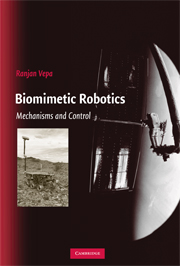Book contents
- Frontmatter
- Contents
- Preface
- Acronyms
- 1 The Robot
- 2 Biomimetic Mechanisms
- 3 Homogeneous Transformations and Screw Motions
- 4 Direct Kinematics of Serial Robot Manipulators
- 5 Manipulators with Multiple Postures and Compositions
- 6 Grasping: Mechanics and Constraints
- 7 Jacobians
- 8 Newtonian, Eulerian, and Lagrangian Dynamics
- 9 Path Planning, Obstacle Avoidance, and Navigation
- 10 Hamiltonian Systems and Feedback Linearization
- 11 Robot Control
- 12 Biomimetic Motive Propulsion
- Answers to Selected Exercises
- Appendix: Attitude and Quaternions
- Bibliography
- Index
9 - Path Planning, Obstacle Avoidance, and Navigation
Published online by Cambridge University Press: 20 February 2010
- Frontmatter
- Contents
- Preface
- Acronyms
- 1 The Robot
- 2 Biomimetic Mechanisms
- 3 Homogeneous Transformations and Screw Motions
- 4 Direct Kinematics of Serial Robot Manipulators
- 5 Manipulators with Multiple Postures and Compositions
- 6 Grasping: Mechanics and Constraints
- 7 Jacobians
- 8 Newtonian, Eulerian, and Lagrangian Dynamics
- 9 Path Planning, Obstacle Avoidance, and Navigation
- 10 Hamiltonian Systems and Feedback Linearization
- 11 Robot Control
- 12 Biomimetic Motive Propulsion
- Answers to Selected Exercises
- Appendix: Attitude and Quaternions
- Bibliography
- Index
Summary
Fundamentals of Trajectory Following
The motion of the end-effector of a manipulator is described by a trajectory in multidimensional space. It refers to a time history of the position, the velocity, and the acceleration of each DOF. Trajectory control is a fundamental problem in robotics and involves two distinct steps. The first of these steps is the planning of the desired trajectory or path of the end-effector. The second is the design and implementation of a suitable controller so as to ensure that the robot does indeed follow the planned path. This step is known as the trajectory or path tracking and is essentially a feedback-control problem. The path tracker is responsible for making the robot's actual position and velocity match the desired values of position and velocity provided to it by the path planner.
Path planning is one of the most vital issues to ensure autonomy of a robot, whether it is a robot manipulator or a mobile robot. It can be viewed as finding a safe and optimum path through an obstacle-filled environment from starting point to some destination in a collision-free manner. Once the desired path of an endeffector is planned there is also concern about the representation of the path for subsequent computational purposes. In the case of manipulators, a continuous time path either in the joint variable space or in a Cartesian base frame is essential. The trajectory controller then synthesizes an appropriate path following the control law based on this continuous time path.
Path planning in mobile robot applications is usually different from the pathplanning problem for manipulators.
- Type
- Chapter
- Information
- Biomimetic RoboticsMechanisms and Control, pp. 164 - 197Publisher: Cambridge University PressPrint publication year: 2009

